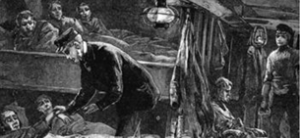They might think twice about pitching tents if they realize one of the deadliest-disease burial grounds lies beneath them
By Bruce Bell –

Bodies were secretly interred in the dark and so carelessly that in walking across the cemetery the next spring, many of the graves were visible down to the coffin lids. Body parts could be encountered drifting up through the mud.
The cholera epidemic that had been ravaging India since 1817 before decimating Europe had at last reached North America and when it finally subsided in here in York, in September 1832, we had reported 205 deaths in a town of about 6,000 inhabitants. In today’s numbers that would be 150,000 people dead in four months.
The summer of 1832 was hot, humid and foul smelling as hogs, horses and chickens were kept side by side while dogs (and some hogs) ran wild in the streets. What flows today underneath our streets in well-contained sewer pipes was then openly flowing down Front Street, making its way to the lake.
At the other end of the town near present-day Berkeley and King was the town’s manure dump and next to that a huge mosquito-filled marsh.
Very little was known on how the disease was spread, so weird ways of preventing it begun to appear here in York. One method was the burning of tar and pitch in barrels outside each dwelling because it was thought that vapours arising from the swamp caused the outbreak. Another means of controlling the spread of disease was to wash the inside of your home with sulphur. However no one realized that living in such filthy conditions led to the spread of germs. But then no one had heard of germs; the term had yet to be invented.
Cholera kills fast and since the numbers of corpses were rising, there was no time for funerals or individual graves. So here lays the big mystery: Where were the victims buried and are they still there? A clue appears in 1832 when Francis Collins, publisher of the Canadian Freeman, wrote in his newspaper: “The most dangerous nuisance in York is the burying ground of the English Church (St. James’ Cathedral). It is situated where no cemetery ought to be, in the very centre of town at King and Church, and so crowded they had to bury the chorea sufferers in a swampy corner where it’s revolting to see remains of human beings deposited in mud and dirty water. Bodies were secretly interred in the dark and so carelessly that in walking across the cemetery this spring we saw some of the graves down to the coffin lids. The cholera swamp ought to covered with six inches with lime.”
The northern end of the old cemetery—now St. James Park—still gets very mushy after a rainfall and some city workers once told me with a wink that bits of bones of the corpses of the “Pit” still rise to the surface. In 1844 a new St James’ Cemetery opened at Parliament and Bloor, where many bodies were moved; but not the cholera victims as it’s not a good idea to disturb the corpses of this horrific disease.
It might be all rumour, but a romantic walk in the rain through St. James Park brings on new meaning knowing there might be between 200 and 2,000 cadavers beneath your feet.
By September 1832 the epidemic ceased and life improved a little for the town with garbage now being collected for the first time, people were fined if they didn’t clean up their yards, and many societies were formed to care for the numerous widows and orphans.
However two years later in 1834 a worse epidemic of cholera hits York that kills a tenth of the population—or about 500,000 in today’s numbers. It would be years before the world woke up to the fact that this disease was caused by germs that bred in the swamps and in the open sewers of cities and fecal matter getting into our drinking water. No wonder that back then “old age” began by the time you hit 30, if you were lucky to get that far.
There is a plaque on the Jarvis side of St. James Park honouring Francis Collins, the early newspaper man, who along with his entire family died in the cholera epidemic of 1834. A fitting place for a marker, considering what may lie below the grassy slopes of St. James Park.
Join me for my Christmas Lights bus tour with afternoon Tea at the King Edward Hotel Dec. 10, 2011 call 416-449-0931 to book. Visit the Bulletin’s website www.thebulletin.ca for ordering details on my new books compiling the last 12 years of my Bulletin history columns. More details on all of the above including my spring trips to New York City and Chicago at www.brucebelltours.ca or call me at 647-393-8687
 TheBulletin.ca Journal of Downtown Toronto
TheBulletin.ca Journal of Downtown Toronto

